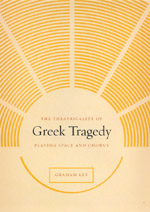
Graham Ley, The Theatricality of Greek Tragedy: Playing Space and Chorus, University of Chicago Press, 2006, 240 p.
Isbn (ean13): 978-0-226-47757-2
Recension par Mary-Kay Gamel (University of California, Santa Cruz) dans Bryn Mawr Classical Review: 2008.10.11
Présentation de l'éditeur:
Ancient Greek tragedy has been an inspiration to Western culture, but the way it was first performed has long remained in question. In The Theatricality of Greek Tragedy, Graham Ley provides an illuminating discussion of key issues relating to the use of the playing space and the nature of the chorus, offering a distinctive impression of the performance of Greek tragedy in the fifth century BCE.
Drawing on evidence from the surviving texts of tragedies by Aeschylus, Sophocles, and Euripides, Ley explains how scenes with actors were played in the open ground of the orchestra, often considered as exclusively the dancing place of the chorus. In reviewing what is known of the music and dance of Greek antiquity, Ley goes on to show that in the original productions the experience of the chorus—expressed in song and dance and in interaction with the characters—remained a vital characteristic in the performance of tragedy.
Combining detailed analysis with broader reflections about the nature of ancient Greek tragedy as an art form, this volume—supplemented with a series of illustrative drawings and diagrams—will be a necessary addition to the bookshelf of anyone interested in literature, theater, or classical studies.
Graham Ley is a reader in drama and theory at theUniversity of Exeter. He has directed ancient and modern plays, hasbeen a dramaturg for professional productions, and is the author ofmany books, including A Short Introduction to Greek Tragedy, also published by the University of Chicago Press.
Sommaire:
Preface
Scope of the Book
Rationale for the Diagrams and Drawings
Further Comments and Acknowledgments
1 the playing space
The Scripts and the Playing Space
The Surviving Tragedies of Aeschylus and Early Tragic Performance
Choros, Actors/Characters, and Playing Space in the Earlier Tragedies of Aeschylus
Persians
Suppliants
Seven against Thebes
Composition for the Playing Space in Aeschylus's Oresteia
Agamemnon
Libation Bearers
Eumenides
Realizing the Tragic Playing Space after Aeschylus
Altars and Tombs in the Playing Space after Aeschylus
Performers and Vehicles in the Playing Space
Three Kinds of Vocal Delivery in Tragedy
Movement and Dancing in the Playing Space
Actors/Characters and Choros: Chanting, Singing and Dancing in the Playing Space
Appendix A: Chronology of the Surviving Plays
2 the chorus
The Choros in Epic
Composition for the Choros
Music: Meter or Measure, Melody, and Mode
Meter Melody and Modes
Dancing
Strophe, Antistrophe, and Choreia
Dithyrambs
The Theatrical Choroi: Definitions and Distinctions
Appendix B: Time Line for Chapter Two
Conclusion
References
Index